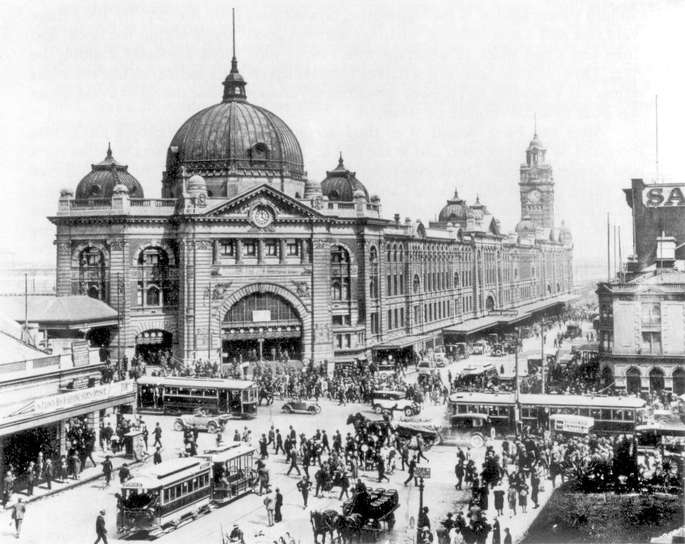Fast Facts
- When: 5th November 2024
- Where: Flemington Racecourse, Melbourne, Australia
- Watch: At The Races
- Official Website: Melbourne Cup Carnival
Australia’s biggest raceday of the year comes in the form of the Melbourne Cup Day which is held every November at Flemington Racecourse in Melbourne, Australia.
The race itself is a flat handicap over two miles and with prize money of A$8.41 million (2023), it is one of the richest in the world. This attract runners and riders from all over the world with many familiar UK and Irish jockeys, trainers and horses competing.
The Melbourne Cup is as popular in Australia as the Grand National is in the UK and as a result is known as ‘the race that stops a nation’ and is even a public holiday for those in the city.
Below we our predictions of what is always a hugely competitive race along with the best besting offers available.
Existing Customer Free Bets & Money Back Offers
Note: Offers will appear here nearer the event as and when they become available.
About The Melbourne Cup
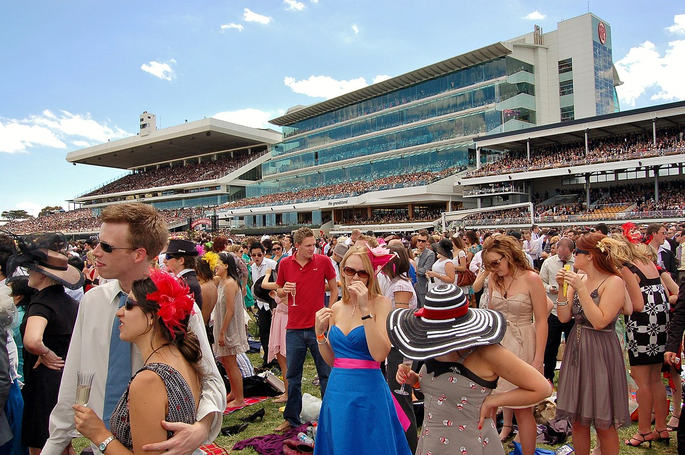
Whilst most horse races not taking place in the UK tend to be developed because a country wants its own version of the British offering, with the Kentucky Derby as America’s alternative to the Epsom Derby being a good example of this, the Melbourne Cup actually came about because the Australian state of Victoria had two horse racing committees in the 1860s that were trying to outdo each other.
The Victorian Turf Club was formed in 1852, whilst the Victorian Jockeys Club was created in 1857. The Jockeys Club had copied English races in the search for events of its own, offering a 2,000 Guineas race to punters, for example. This gave them a degree more cachet than the more traditional races being offered by the Turf Club and so Victoria’s original racing committee decided that it needed to come up with something special in order to attract punter’s to its races at the expense of its rival.
So it was that on the seventh of November 1861, the Turf Club created a race that it called the Melbourne Cup and decided would be a handicap offering. The thought was that creating a race that would theoretically be ‘even’ for all horses entering it would cause a degree of speculation and excitement around which horse would win and that would in turn see more people attending the race and therefore a bigger prize on offer. It worked, with over four thousand spectators turning up to watch the first running of the race, a crowd that surpassed anything else that the Turf Club had managed over the previous two years.
Mormon And Archer Do Battle in the First Melbourne Cup
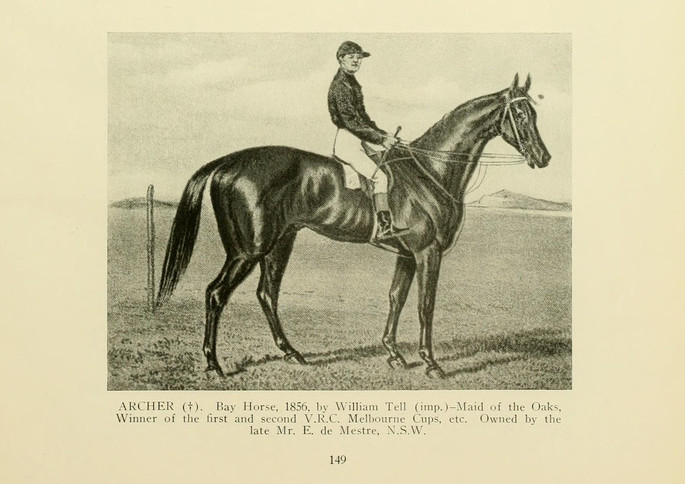
The first race saw a horse bolt before it began, with another three falling early on. Still, those in attendance thought that they would watch a locally trained horse named Mormon win it easily. They were in for a surprise, however, thanks to the presence of another horse that had travelled from Melbourne to Sydney on a steamboat. That horses was named Archer and the fact that it wasn’t known by the bookmakers of Melbourne means that it was entirely unfancied. Those that chose to have a punt on Archer were left delighted when he finished the race six lengths ahead of Mormon, leaving the local punters disappointed. Having made the effort to travel to the city by steamboat, Archer’s owners made the most of it and entered him in the two-mile Melbourne Town Plate the day after the Melbourne Cup, which Archer also won.
The following year the bookies were far more aware of Archer’s ability, having lost money because of him in the race’s inaugural running. When the horse once again entered the race, having made its annual trip by steamboat, he did so with much lower odds. That didn’t stop the eight thousand or so spectators who had turned out to watch him run cheering him on, with Archer beating nineteen other horses to to win the Melbourne Cup for the second year running. Mormon was once more the runner-up, missing out on the trophy for the second time.
Archer was expected to defend his crown for a third consecutive time in 1863, only for an administrative error to stop him from being allowed to do so. Despite once again jumping on the speedboat to head to Melbourne, race organisers refused him entry because the telegraph from Archer’s trainer, Etienne de Mestre, failed to arrive in time after a postal strike in the country. The refusal to allow Archer to race led to many of the owners who also used de Mestre to train their horses to pull them out of the race, meaning that the 1863 Melbourne Cup took place with just seven horses running. That remains the lowest number to take part in the race to this day.
The Victorian Racing Club
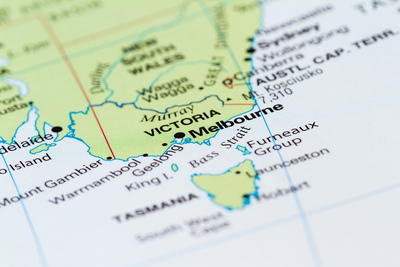
The Melbourne Cup was such a success that there could no longer be an argument regarding which was the pre-eminent race organising committee in Victoria; the Victoria Turf Club had won the battle. Rather than continue with two different organising committees, potentially weakening racing in the state, the two chose to combine their efforts and so the Victorian Racing Club was formed in 1864.
One of the first things that the Racing Club decided to do was to commission the creation of an actual cup for the winner of the Melbourne Cup to be presented with. Having boasted the name ‘Melbourne Cup’ from the very start, it’s amusing that the race actually had a gold watch and some money as its prize for the first four years. The first actual cup was presented in 1865 and, ironically enough, the winning owner considered it to be so ugly that they sold it.
The first ever Melbourne Cup was rebranded as the Flemington Hunt Cup by the people that bought it, eventually being bought by the Museum of Australia in 2012. The Racing Club decided that a rebrand was in order and so a new cup was created for the 1866 race.
The Race’s Development
By 1865 the Melbourne Cup was so beloved by people in the area that ‘Cup Day’ was an unofficial half-day for bank officials and public servants in the city. Many local businesses also shut up shop in time for the lunchtime race, with that particular tradition leading to the Victoria Government Gazette officially declaring it to be a public holiday by 1873. Two years later and the race was moved to the first Tuesday in November for the first time; a location at which it has remained ever since.
In 1876 a horse named Briseis won the Melbourne Cup with a time of just shy of three minutes. Whilst this was impressive enough, the three-year-old filly went on to win the VRC Derby and then the VRC Oaks. That this treble took place in the space of just six days was enough to cause a stir, but the real clincher in terms of gaining the admiration of the watching public came in the form of the jockey being a thirteen-year-old named Peter St. Albans. The Melbourne Cup suddenly went from being a race that those based in the city enjoyed to one that the rest of Australia sat up and noticed.
The biggest development in the history of the race came about in 1972 when Australia moved to the metric system and the race’s length changed accordingly. Having been just over two miles when it first took place, the Melbourne Cup has been just under two miles long ever since. In 1987 Maree Lyndon made history when she became the first female jockey to take part in the race.
Given that just over four thousand people turned up to watch the inaugural Melbourne Cup in 1861, it’s fair to say that the changes that have been made to the event over the years have been welcome ones, given that by 2005 more than one hundred thousand spectators arrived at Flemington Racecourse to watch the horses competing for the cup.
Race Format
As mentioned at the start, the Melbourne Cup is a handicap race. It boasts a maximum weight of no less than fifty-seven kilograms, with the weight placed on the horses in terms of a handicap dictated by the Victorian Racing Club Handicapper in September. As with most handicap events, older horses are asked to carry more than younger ones. Unlike the majority of handicaps, however, the Melbourne Cup isn’t what is known as a ‘pure handicap race’. Instead, weights are adjusted into what organisers refer to as a ‘quality handicap’, which is designed to make the event more exciting.
The Melbourne Cup is run over 3,200 metres, which is just under two miles in English money. It’s run left-handed around a turf course and is known as the richest handicap in racing.
The prize pot in 2023 had more than 8.4 million Australian dollars on offer, with the winner receiving almost £2.5 million (A$4.8 million). It’s an interesting race, with the first twelve horses that cross the finish line guaranteed a prize. In 2023, the amounts worked out as follows:
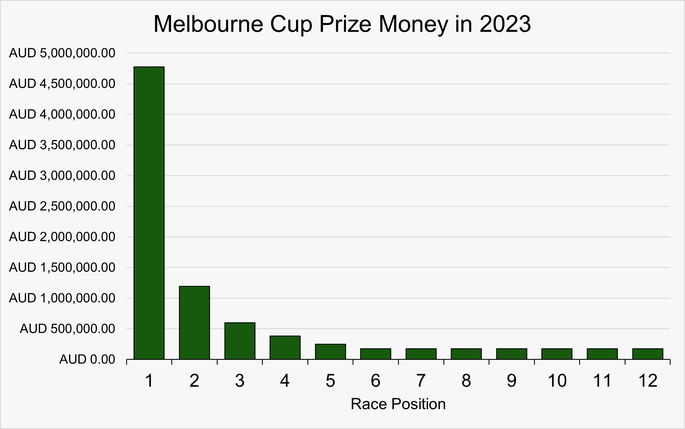
The split of the winnings sees 85% heading to the horse’s owner, 10% to the trainer and 5% to the winning jockey. There is also a bonus of $500,000 dollars available to any owner of a horse who can win the Irish St. Leger in the September and follow up with the Melbourne Cup in November.
Race Qualification
The popularity of the Melbourne Cup means that it’s an extremely popular one for horses to be entered into. As a result, there are certain criteria that must be met by owners hoping to see their horses take part in it. The first hoop through which they must jump is the paying of $600 dollars when horses are first entered for the race. Only twenty-four horses get to race in the Melbourne Cup every year, with the field being whittled down from more than four thousand entries.
Horses that are brought into the country from elsewhere, with the exception of New Zealand, have to spent fourteen days in quarantine before their allowed to take part in the race. That is one way in which potential entires are slimmed, with some owners not willing to force their horse to go through that process.
Another way is via the sheer amount of money that it costs to enter a horse into the race. There are four different points during the year at which an entry must be confirmed, with an ever-rising amount of money necessary to be spent in order to make it through these phases. They are as follows:
Melbourne Cup Qualification Fees
| Round | Cost |
|---|---|
| First Acceptance | $960 |
| Second Acceptance | $1,450 |
| Third Acceptance | $2,420 |
| Final Acceptance | $45,375 |
Obviously there will still be more than twenty-four horses that make it through that process, which means that the ultimate decision about whether or not a horse will be accepted into the race lies with the organising committee and the race directors. Factors such as the amount of prize money earned during the preceding year as well as how many races the horses have won will be taken into account before the committee allows a horse entry. Winners of the Irish St. Leger, the Doncaster Cup and the Cox Plate, as well as a host of other races, are exempt from the ballot.
About Flemington Racecourse
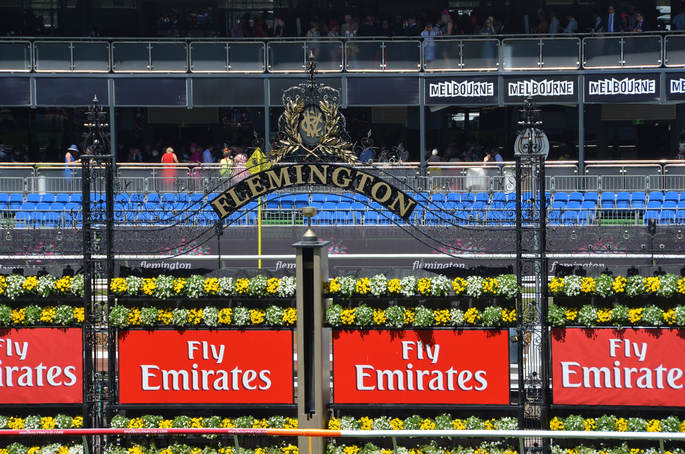
The area where the racecourse is located was first used for racing as early as 1840, with Victoria Turf Club soon deciding that it would be an ideal place to build a racecourse and taking out a lease on the land in 1844. The course’s shape is similar to that of a pear, having a long neck and a fat belly. The straight is six furlongs in length and over one hundred and twenty thousand people can fit into the three grandstands.
In the early 2000s, one of the grandstands was refurbished at a cost of more than $45 million. In 2006 Flemington Racecourse was given Australian National Heritage status. That is at least partly due to the number of top-class races that it hosts, with the Lightning Stakes, the Australia Cup and the Victoria Derby all joining the Melbourne Cup in being hosted at the venue.
Interesting Facts
Having been running for nearly two hundred years, it’s not a shock to learn that the Melbourne Cup boasts a number of facts that are worthy of the name. Some of the best include the following:
- Though Archer was the first horse to win the race twice, Peter Pan, Rain Lover and Think Big have all done so since
- The most successful horse of all time, however, is Makybe Diva, who won it three times from 2003 to 2005
- Bart Cummings won his first Cup as a twenty-three-year-old as a trainer, going on to win it eleven more times and set a record
- There is a fashion show called Fashions on the Field that takes place every year around the Melbourne Cup Carnival, first taking place in 1962
- Kingston Rule’s three minutes and sixteen point three seconds is the current record for the Melbourne Cup, set in 1993
- Michelle Payne became the first female jockey to win the race when she did so in 2015

